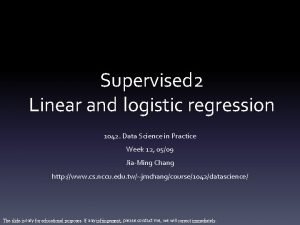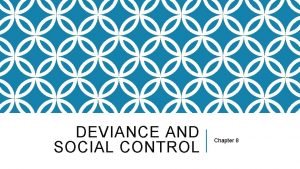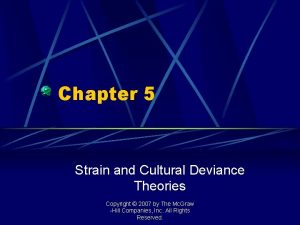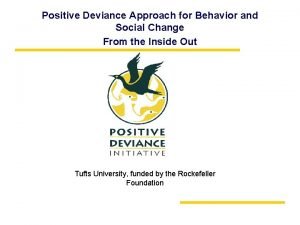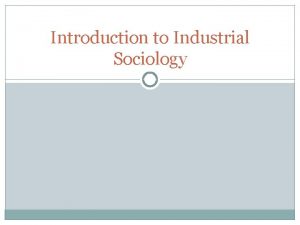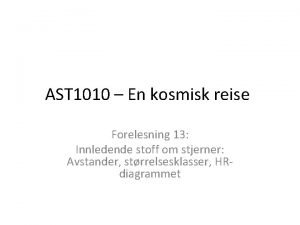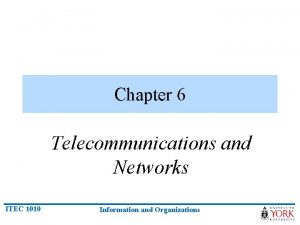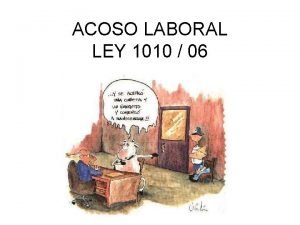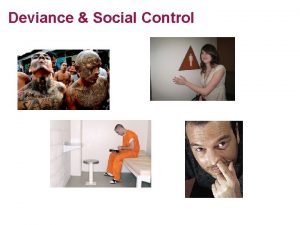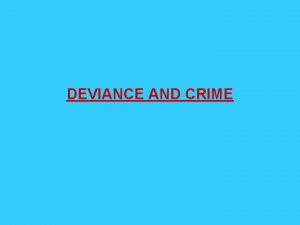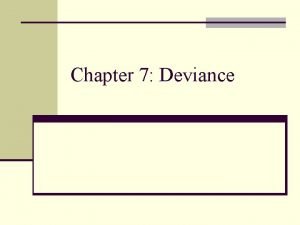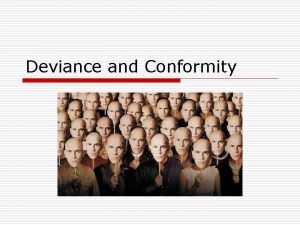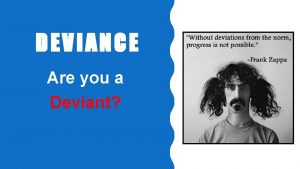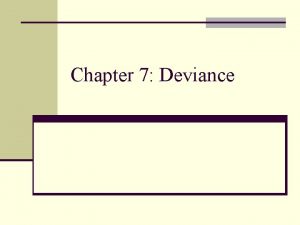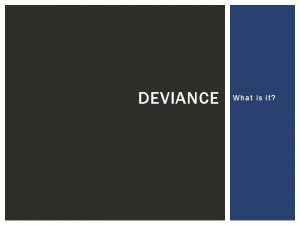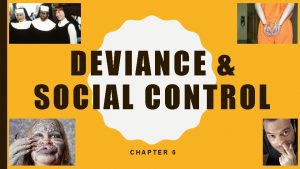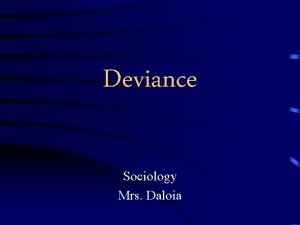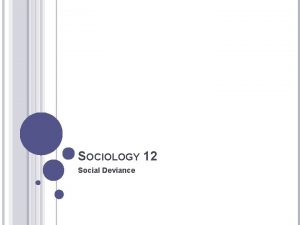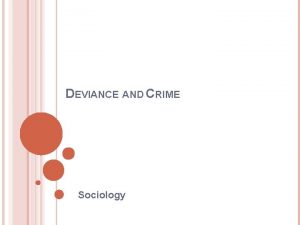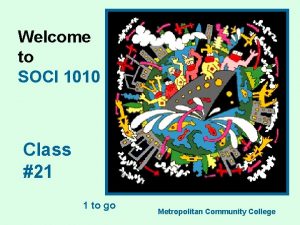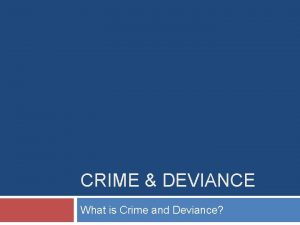Welcome to SOCI 1010 Introduction to Sociology Deviance







































- Slides: 39

Welcome to SOCI 1010 Introduction to Sociology Deviance of another sort….

Agenda for Class #12 • Note book check • Continue Deviance

Deviance Chapter 7 http: //en. wikipedia. org/wiki/Leonard_Peltier

• Leonard Peltier (born September 12, 1944) is an American activist and member of the American Indian Movement (AIM) who was convicted and sentenced in 1977 to two consecutive terms of life imprisonment for aiding and abetting the execution style murder of two Federal Bureau of Investigation agents during a 1975 shootout on the Pine Ridge Indian Reservation. Peltier's indictment is the subject of the 1992 documentary Incident at Oglala, a film by Robert Redford and Michael Apted. • Peltier's supporters present him as a political prisoner, although his murder conviction has survived appeals in various courts.

• Amnesty International issued this statement: "Although he has not been adopted as a prisoner of conscience, there is concern about the fairness of the proceedings leading to his conviction and it is believed that political factors may have influenced the way the case was prosecuted. "[1] Numerous lawsuits have been filed on his behalf but none has succeeded. • Peltier is currently incarcerated at the United States Penitentiary, Lewisburg, Pennsylvania. His projected release date is October 11, 2040. [2] • On July 28, 2009, Peltier was granted a full hearing before the United States Parole Commission. On August 21, 2009, US Attorney Drew Wrigley announced that Peltier’s parole request had been denied. • Peltier's next scheduled hearing will be in July 2024. [3]

Explanations for Deviant Behavior • Supernatural • Classical Criminology • Positivism

Classical School • Individuals are aware of the consequences of actions and if the consequences are rational, fair and certain and if individuals choose deviant actions, then they should be punished. Let the punishment fit the crime.

Positivistic Response • There are some circumstances that are out of the individual’s control • There are individuals who are unable to make rational choices

Positivism • Therefore, there are times when it is impossible to hold the individual responsible • There are times when we need to “treat” the individual instead of punishing Let the punishment fit the offender

Review • Deviance is violation of __? __. • In a supernatural explanation, the cause of deviance is __? __. • Classical criminology says, “Let the punishment fit the __? __. • Positivism says, “Let the punishment fit the __? __.

Positivistic Explanations for Deviance • Biological • Psychological • Sociological

Biological Explanations • Lombrosian Positivism (Cesare Lombroso) • Phrenology • Somatotypes (Wm. Sheldon, the Gluecks) • Hormone imbalance • XYY Chromosome theory


Richard Speck

Flaws in the Biological Theories • • Only explains a few minor cases Studies did not include control groups Male- biased studies Some forms of treatment may be impossible or inhumane

Psychological Explanations Psychoanalytic (Sigmund Freud) • ID - selfish, pleasure orientation • EGO - reality orientation • SUPEREGO - morality orientation

Psychological Explanations, continued • Insufficient personality – Too much ID – Not enough superego – Weak ego

• Frustration / Aggression – Given excessive frustration, individuals will become aggressive – ex. Urban crowding, competition for resources

• Mental illness • Pathological conditions – Insanity - at the time of an action (crime) – Incompetence - at the time of a court hearing – Case of Vernal Walford

• It was every parent's worst nightmare come to life. On Dec. 20, 1974, Carter Zeleznik and his 9 year-old boy, Arnold, were walking down the second-floor corridor of the Crossways Airport Inn on Lejeune Road in Miami. Carter reached into his pocket and discovered the room key. Realizing that his wife, Betty, and younger son, Bobby, would be unable to lock up when they were finished changing out of their swimming suits and ready to leave the room, Carter told Arnold to wait where he was for a minute while he returned the key to Betty. • From: FIRST BORN. The Death of Arnold Zeleznik, Age Nine: Murder, Madness and What Came After. By John Katzenbach. 284 pages. Illustrated. Atheneum. $14. 95.

Treatment for Psychological Causes • Institutionalization and therapy • Aftercare for psychiatric patients • Socialization of morality – Agents of socialization: parents, school, church, media, peers, etc.

Sociological Explanations • Anomie Theory • Differential association and other socialization theories • Labeling theory Durkheim

Anomie Theory Emile Durkheim • Anomie = Normlessness Deviance results when the norms are weak or conflicting; rapidly changing so that they no longer control the individual’s behavior • Anomic suicide - killing oneself when not sure what else to do.

Variations on Anomie Theory Robert Merton Discrepancy between goals and socially accepted means to achieve them • Conformity is non-deviant Innovation Retreatism Ritualism Rebellion

Merton’s Deviant Adaptations • Innovation Accept goals Reject means • Ritualism Reject goals Accept means • Retreatism Reject goals • Rebellion Reject goals but replace with new ones Reject means but replace with new ones

Differential Association Edwin Sutherland • Chicago school • Symbolic Interactionism • Deviance is learned in primary groups and from significant others • Provides the rationale for separate juvenile facilities and programs

Differential Association, In Detail • Criminal behavior is learned • It is learned in interaction with others via the process of communication • Learning occurs primarily within intimate personal groups • Learning includes techniques, motives, drives, rationalizations and attitudes toward deviance and crime

Labeling theory • Behavior is deviant when others label it as deviant • Labels may be: – informal - name calling – formal - applied by some designated official • Status degradation ceremony

Labeling theory • Primary Deviance – isolated incidents – no label attached • Secondary Deviance – lifestyle deviance – deviance becomes an occupation – label is attached Edwin Lemert (1912 -1996)

Treatment from a Sociological Perspective • Adequate, appropriate socialization experiences • “repair” negative social conditions – ie. , poverty, unemployment, illiteracy, despair, prejudice

Treatment, continued • Identify and enforce the rules • Equity for individuals to seek and achieve goals • Avoid arbitrary labels • Good role models – teachers, parents, “big brothers and sisters”, mentors

Purposes of Punishment • Prison as an example • Revenge, retribution • Deterrence – general - for everyone – specific - for offender • Incarceration, incapacitation – out of circulation

Punishment, continued • Rehabilitaion • Restitution Victim compensation

In Small Groups • Think of ways that these purposes have been used in specific cases • How well do they work? • What alternative treatment of the offender may have worked better? • Be ready to report out in 10 minutes.

What Can We Do to Control Deviance? • Prevention and public awareness • Primary prevention - before it happens • Secondary prevention - prevent it from getting worse • Individual solutions • Societal solutions (treatments) • Governmental intervention

Measuring and Reporting Crime • FBI - Uniform Crime Reports – Index offenses – Other crimes • Problems with official reports • Victim surveys • The Crime Clock represents the annual ratio of crime to fixed time intervals.

The Crime Clock, based on 2006 crime data • • • One major crime reported every 32 minutes One violent crime reported every 4 hours One homicide every 13 days One forcible rape every 4 days One robbery every 9 hours One aggravated assault every 8 hours One property crime reported every 36 minutes One burglary every 2 hours One larceny every 58 minutes One auto theft every 7 hours


Assignment • Conclude deviance • Social Stratification Chapters 8 and 9
 Null deviance vs residual deviance
Null deviance vs residual deviance Crime and deviance sociology revision
Crime and deviance sociology revision Deviants chapter 8
Deviants chapter 8 Primary deviance definition
Primary deviance definition Culture conflict theory
Culture conflict theory Positive deviance sociology definition
Positive deviance sociology definition Nab��dka pr��ce soci��ln�� pracovn��k
Nab��dka pr��ce soci��ln�� pracovn��k Ponuka pr��ce soci��lny pracovn��k
Ponuka pr��ce soci��lny pracovn��k Welcome welcome this is our christmas story
Welcome welcome this is our christmas story Introduction to sociology 9th edition
Introduction to sociology 9th edition Nature and scope of industrial sociology
Nature and scope of industrial sociology Introduction to anthropology psychology and sociology
Introduction to anthropology psychology and sociology The real world an introduction to sociology
The real world an introduction to sociology Anthropology sociology psychology venn diagram
Anthropology sociology psychology venn diagram Introduction to sociology
Introduction to sociology Introduction to anthropology psychology and sociology
Introduction to anthropology psychology and sociology Sociology as a science essay
Sociology as a science essay Introduction to sociology tischler
Introduction to sociology tischler Zal er ooit een dag van vrede tekst
Zal er ooit een dag van vrede tekst John 10:10 nkjv
John 10:10 nkjv Fischione 1010 ion mill
Fischione 1010 ion mill 1010 101
1010 101 Williams w-1010
Williams w-1010 Ast 1010
Ast 1010 Ast1010
Ast1010 Braun multimix 1 hm 1010 wh
Braun multimix 1 hm 1010 wh Eesc 1010
Eesc 1010 Computer systems engineering carleton
Computer systems engineering carleton 011 101 110
011 101 110 English 1010 slcc
English 1010 slcc To remember a list of the school supplies she needs
To remember a list of the school supplies she needs Ilarawan si songhai
Ilarawan si songhai Itec 1010
Itec 1010 Qué es persecución
Qué es persecución Log 1010
Log 1010 Weizmann
Weizmann Fleischmarkt 1 1010 wien
Fleischmarkt 1 1010 wien Explorer post 1010
Explorer post 1010 Ast 1010
Ast 1010 1010 internet
1010 internet
